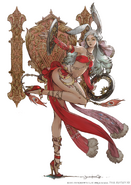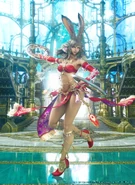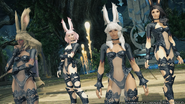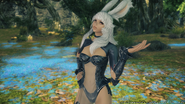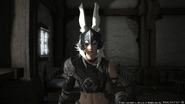Viera is a race from Final Fantasy XIV, introduced in Shadowbringers. Viera first appeared in the series in Final Fantasy Tactics Advance, but their most prominent appearance was in Final Fantasy XII.
In the First, this race is known as Viis, while in Tural they are known as Shetona.
Profile[]
The Viera is a leporine race of people commonly found in Southern Othard. While the majority of their population resides closed-off from the rest of the world in the Golmore Jungle, in recent times more have decided to leave the safety of the forest to explore the world. As such, it is estimated that the Kingdom of Dalmasca is comprised of around 5% of Viera.
The Viera in Golmore Jungle live under a strict code, the "Green Word" (also known as the Word of the Wood),[1] that forbid them from interacting with the outside world unless strictly necessary. Those who leave to discover the world are forever banished, never to return.
In the alternate world the First, the Viera are known as "Viis" and live in the Rak'tika Greatwood as caretakers for the ruins of lost empire of Ronka.
On the western continent of Tural, the "Shetona", as Viera are called there, mainly live in the northern Xak Tural. The Shetona homeland is Yyasulani.
Male Viera is available as a playable option in Final Fantasy XIV: Endwalker.
Physiology[]
It is estimated that around 80% of Viera are born female, with males and females being identical at birth until they leave adolescence and reach adulthood around the age of 13, which is when males become distinguishable from females.[1]
Viera (and Viis) live for hundreds of years, easily longer than three lifetimes of an Elezen, who are known to live longer than many other races themselves.[2] Viera retain their physical youth for centuries, making it nigh impossible to discern the age of a Viera from their outward appearance.[1]
Even though male Viera are the main guardians of the jungle, the martial prowess of female Viera is not to be underestimated as they are just as formidable as the men, merely choosing to devote their attention to the protection of their hearth and young.[1]
Male Vieras tend to be shorter than their female counterparts.
Culture[]
The word "Viera" itself means "people of the wood" and a Viera child is referred to as a "kit".[1]
Like the Keepers of the Moon, Viera tribes are a matriarchal society that is ruled by, and mostly comprised of, women. Viera men are rare and remain deeply solitary, except when they return to their village of birth every three to five years to mate.
While the men are the primary defenders, Viera women still defend the forest but they also devote time to responsibilities such as clearing undergrowth, removing fallen trees, planting seeds and eradicating vermin among other tasks.[1]
The Viera refer to aether as Mist, as demonstrated by Fran Eruyt at Orbonne Monastery.
The response the Wandering Dramaturge got after asking a Viera woman "if she did not find her tribe's ways awkward. Was it not within the natural order for males and females of a species to coexist?" was:
- "The value of coexistence will not be found 'neath a loincloth. Long has our kind endured understanding that the distance 'twixt two bodies does not dictate the distance 'twixt two souls."
The Shetona of Tural mainly live in the wooded regions of the northern half of the continent, Xak Tural, though some can also be found in the south in the city of Tuliyollal. Like Dalmascan Viera, the Shetona villages are primarily the home of the women; men travel between villages and father families in each with different women, visiting those families as they return to the villages with the passing of seasons. Shetona that choose to live in cities may still decorate their homes with natural items like plants and stones to "cleanse" it and keep it in tune with nature.[3]
In the alternate world the First, the Viera are known as "Viis" and much of the culture from the Viera of the Source is retained in the Viis culture itself, from being a matriarchal society and excluding males from their villages to said villages being formed around massive trees, linked by suspended paths.
Wood-warders[]
Despite being excluded from villages, male Viera still play an important role in Viera society by taking on the mantle of Wood-warders, serving as protectors of the forest. The duty of a Wood-warder is to ensure that the domain of their tribe is untouched by the destructive whims of outsiders.[1]
Male Viera return to their village every three to five years not only to mate but to claim any young males that have entered adulthood yet still live within the village, as their wards, to teach them how to survive in the wilderness on their own and without the crutch of companionship.
Only after many seasons of training and strict adherence to the Word of the Wood will the students earn the title of master and be allowed to seek solitude.
The training required to become a Wood-warder often leaves more than a few to perish during the brutal rite of passage, further thinning the number of males in the tribe.
It is standard that Wood-warders attack from the shadows, often shooting first and not even bothering with asking questions.[1]
Viera men must remember to always pay proper respect to those elder than them, or else they may not live to be an elder themselves.[3]
Naming conventions[]
Forenames[]
The Rava and Veena clans share many traditions, naming practices among them. Thus, a Viera's forename is not indicative of the clan to which she belongs—rather, it is the lifestyle she leads that determines whether she bears a "forest" or "city" forename. Traditional Viera forenames given at birth are also referred to as "forest names," as they are used by those Viera still residing in their homeland—which is the Golmore Jungle, in the case of the Rava, or the forest skirting the Skatay Range for the Veena. Forest names resemble real-world Scandinavian names and are pronounced similarly—in the names "Theja," and "Nojra," for instance, the "j" sounds more like an English "i."
Because a Viera's male or female characteristics are not present at birth, parents typically opt to bestow their children with names that are considered appropriate for any sex and gender. Nevertheless, in line with the cultural tradition of adopting a new name to suit one's newfound environment or identity, many Viera choose to change their names upon reaching adulthood. Though in many cases male Viera will choose a traditionally "masculine" name, or female Viera a traditionally "feminine" one, there are myriad examples of Viera who eschew these patterns by keeping or choosing names that are culturally recognized as non-binary or associated with a different gender. For this reason, it is nearly impossible to determine whether a Viera is male or female by forename alone.
Furthermore, in keeping with the aforementioned tradition, the majority of Viera who choose to leave their homes and strike out into the wider world also adopt new "city names" to mark their parting from the traditional Viera way of life. These names are often inspired by the names of other races they encounter, or simply things that they like, such as "Cherry" or "Morning Glory," and so vary widely between individuals. Incidentally, "Fran" is one such name.
Forest names include:
- Ruuj, Shara, Rena, Rael, Bjonse, Arjm, Coeli, Ysera, Yurhee, Venase, Ukina, Sonja, Slejsa, Qestra, Petra.
Surnames[]
In the Viera's forest homeland, surnames are taken from the name of the village of one's birth. As many female Viera remain in the same forest that they were born, they tend to keep their childhood surnames throughout their lives. However, as with forenames, surnames are generally discarded or replaced once one chooses to venture into the wider world, as a means of symbolizing the severing of ties with one's homeland. Thus, the majority of female Viera abroad, as well as most male Viera, do not make use of their original surnames.
Though female Viera may choose their new surnames, male Viera typically take the same surname as the elder male under whom they train upon first departing their village for the wider forest. The conventions for such surnames vary by clan, but in all cases mark their bearers as noble guardians of the wood.
Common Rava surnames include:
- Hyskaris, Eruyt, Camoa, Muscadet, Atoel, Bysnoe, Dei-Ijla, Fyth, Golmarr, Iryut.
Common Veena surnames include:
- Lesrekta, Arda, Ymir, Bosco, Gucuma, Kisne, Tehp, Paharo, Muruc.
Male-specific Rava Surnames[]
Male Rava inhabit the forest surrounding the village in which female members of their clan reside, forming a sort of perimeter in defense of both the wood and its people. They believe that their purpose is to maintain the natural balance of the six elements in their dual polarities—to ensure harmony between the twelve aspects that comprise our star and the heavens above.
In accordance with this philosophy, each Rava surname begins with a syllable to represent either the celestial realm (Djt) or the worldly realm (Rehw), followed by a word that represents one elemental aspect within it. It is believed that those sharing a realm or an element possess a bond that grants them insight into one another's minds, and as such are wont to join forces when the need for collaboration arises. Further rumors suggest that the Rava consider it necessary that all twelve different surnames be present among the Wood-warders' ranks at any given time to ensure the forest's safety and, should any be unaccounted for, will rename a member with a close affinity to said surname to fill the open spot.
Male Rava surnames include:
- Rehw-Nong ("Frost" – worldly ice)
- Djt-Nong ("Moon" – heavenly ice)
- Rehw-Marouc ("Spring" – worldly water)
- Djt-Marouc ("Star" – heavenly water)
- Rehw-Bidit ("Treetop" – worldly wind)
- Djt-Bidit ("Tempest" – heavenly wind)
- Rehw-Dvre ("Arrow" – worldly lightning)
- Djt-Dvre ("Thunderstrike" – heavenly lightning)
- Rehw-Gilda ("Sword" – worldly fire)
- Djt-Gilda ("Brush Fire" – heavenly fire)
- Rehw-Setlas ("Fertile Soil" – worldly earth)
- Djt-Setlas ("Cliff" – heavenly earth)
Male-specific Veena Surnames[]
In the mountainous region inhabited by the Veena, villages are frequently enveloped by heavy snows. A male Veena's surname marks him an integral, albeit small, part of this landscape, combining references to snow crystals with the word "wesfv"—"guardian." However, as the snowflake-based themes employed and the number of surnames in use differ from village to village, the examples below should be considered only a small sampling of the possibilities.
Unlike the Rava, the Veena are not known to regard their Wood-warders as sharing any particular affinities or bonds due to their surnames.
Male Veena surnames include:
- Sjadarwesfv ("Needle")
- Jgnewesfv ("Sheath")
- Monnawesfv ("Prism")
- Huorlwesfv ("Shield" – referring to what naturalists term "plates")
- Ornedwesfv ("Fan" – referring to "sectored" plates)
- Qufiswesfv ("Bullet")
- Foixewesfv ("Spear")
- Ubmuawesfv ("Wand" – referring to gohei twins)
- Copihwesfv ("Branch" – referring to dendrites)
- Rawbewesfv ("Bone" – referring to hollow crystals)
- Phiitehwesfv ("Seagull")
- Gahjewesfv ("Rime")[4]
Attribute modifiers[]
The following table shows the attribute modifiers for Viera. These are flat modifiers and do not scale with level, only making a noticeable difference at low levels and very quickly becoming negligible as these attributes climb into the hundreds and thousands.
| Clan | STR | DEX | VIT | INT | MND |
|---|---|---|---|---|---|
| Rava | 0 | 3 | -2 | 1 | 1 |
| Veena | -1 | 0 | -1 | 3 | 2 |
Notable members[]
Behind the scenes[]
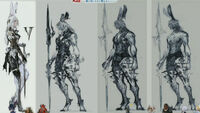
Concept art showing female and male viera from Heavensward.
The Viera was considered as the new race to be included in the Final Fantasy XIV: Heavensward expansion. While at first fans were apprehensive at the possibility of it being a female-only race, the development team revealed they had drawn up concepts for male Viera. They also showed concepts of a younger variation, similar to the feol Viera (from Final Fantasy XII: Revenant Wings). However, the idea was discarded in favor of the Au Ra.[5]
In the Fan Festival held in November 2018 Producer and Director Naoki Yoshida, and the translator and English localization lead Michael-Christopher Koji Fox, joked throughout the keynote about Yoshida's shirt, which featured Bugs Bunny on a motorcycle. The camera zoomed in on it just after announcing an "unknown new playable race". Yoshida also hinted that the final chapter in the Return to Ivalice raid would feature a huge hint;[6] this hint turned out to be Fran Eruyt playing a role in the raid storyline, marking the first appearance of a Viera in Final Fantasy XIV.
The Viera were confirmed as a playable race for Final Fantasy XIV: Shadowbringers at the 2019 Final Fantasy XIV Fan Festival in Paris on February 2, 2019. Only female Viera were shown, leaving many to speculate that males might follow. This speculation was proven to be false; instead, an all-male race known as the Hrothgar was inserted to complement the Viera. The rationale given was the same as for Final Fantasy XII: that males were too reclusive and aggressive.
Preliminary fan response to the changes announced was mixed, with reports of backlash on social media and official discussion forums.[7] In his Letter from the Producer, LXII, Yoshida answered to the criticism citing the cost of developing a new race, and how Viera and Hrothgar would likely be the final races to be added to the game, requiring new faces, hairstyles, bodies, and other assets and to be capable of equipping all existing items. While Viera was a popular fan demand, there had also been calls for more beastly variety to playable characters. The team thus felt that it was in their best interests to try and satisfy both demands. Though understanding that some players would be upset at being unable to use their preferred gender, the team decided to add gender-locked races as the best way to "improve the overall game experience".[8]
Male Viera would later be released with Final Fantasy XIV: Endwalker in response to fan feedback. Erenville was the first male Viera to appear not only in Final Fantasy XIV, but in fact in the entire series.
Gallery[]
Etymology[]
Viera is a word in Slovakian language meaning "faith". It also appears in other Slavic languages with small changes in spelling or pronunciation, and is often used as a feminine name. Viera is also an Italian word meaning "ring", and is used as a surname particularly in Northern Italy.
Citations[]
- ↑ 1.0 1.1 1.2 1.3 1.4 1.5 1.6 1.7 Wandering Dramaturge
- ↑ Top of the Tree Urianger:
I hope thou wilt not think the question impertinent, but did thy people's [Viera] famed longevity perchance play a part in the emperor's decision to entrust this mission unto thee and thine?
Almet:That was one reason, yes. We Viis would easily live to see three of your elven lifetimes.
Main Scenario (Shadowbringers), Final Fantasy XIV - ↑ 3.0 3.1 The Cycle of Life
- ↑ Viera Naming Conventions (Accessed: March 15, 2022) at Official forums
- ↑ Viera From Final Fantasy XII Were Considered as Final Fantasy XIV’s New Race; Male Concept Revealed (Accessed: April 26, 2015) at DualShockers
- ↑ Final Fantasy 14 getting new Shadowbringers expansion, Blue Mages and more (Accessed: November 24, 2018) at Polygon
- ↑ Gender-locked race? (Accessed: July 22, 2019) at Square Enix Forums
- ↑ Thread: Letter from the Producer, LXII (05/09/2019) (Accessed: July 22, 2019) at Square Enix Forums



